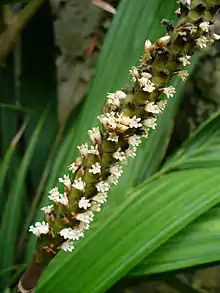Calyptrogyne ghiesbreghtiana
Calyptrogyne ghiesbreghtiana, commonly called the coligallo palm (Spanish for rooster tail, a reference to the form of the leaf), is an understory palm native to Central America and southern Mexico,[1][2][3] where it grows in tropical rainforests.
| Coligallo palm | |
|---|---|
 | |
| Scientific classification | |
| Kingdom: | Plantae |
| Clade: | Tracheophytes |
| Clade: | Angiosperms |
| Clade: | Monocots |
| Clade: | Commelinids |
| Order: | Arecales |
| Family: | Arecaceae |
| Genus: | Calyptrogyne |
| Species: | C. ghiesbreghtiana |
| Binomial name | |
| Calyptrogyne ghiesbreghtiana | |
| Synonyms[1] | |
| |
It is a stemless or short-stemmed palm with a trunk up to 2 m tall. The leaves are undivided, or pinnate with 3-9 leaflets, the terminal leaflet with a forked apex. The flowers are produced all year round, on upright inflorescences; they are monoecious, with complete temporal separation of the male and female stages. The flowers are pollinated by bats in the family Phyllostomidae. Because the flowers are made of a sweet chewable tissue (like the pulp of a fruit) they are much favoured by katydids (Tettigoniidae), whose feeding reduces the number of flowers available to be pollinated.
The inflorescences host a species of mite (Acari) which live and reproduce on the inflorescence and travel to new inflorescences by hitching a ride on the flower-visiting bats. The behaviour of parasitising another animal for transport but not food is known as phoresy. A similar phenomenon which has been more comprehensively surveyed are the mites that live in flowers visited by hummingbirds and are phoretic on these flower-visiting birds.
Four subspecies are recognized:[1]
- Calyptrogyne ghiesbreghtiana subsp. ghiesbreghtiana - Veracruz, Tabasco, Chiapas
- Calyptrogyne ghiesbreghtiana subsp. glauca (Oerst.) A.J.Hend. - Costa Rica, Panama, Nicaragua
- Calyptrogyne ghiesbreghtiana subsp. hondurensis A.J.Hend. - Honduras
- Calyptrogyne ghiesbreghtiana subsp. spicigera (K.Koch) A.J.Hend. - Belize, Guatemala
References
- Kew World Checklist of Selected Plant Families
- Pérez J., L. A., M. Sousa Sánchez, A. M. Hanan-Alipi, F. Chiang Cabrera & P. Tenorio L. 2005. Vegetación terrestre. 65–110. In J. Bueno, F Álvarez & S. Santiago Biodiversidad del Estado de Tabasco. CONABIO-UNAM, México
- Henderson, A., G. A. Galeano & R. Bernal. 1995. Field Guide to the Palms of the Americas 1–352. Princeton University Press, Princeton, New Jersey